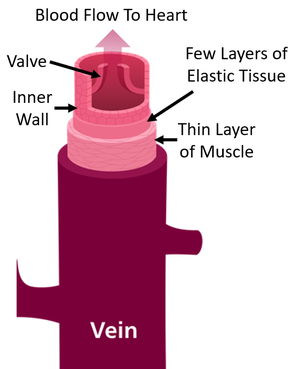Difference between revisions of "Vein"
(→Adaptations of Veins) |
|||
| Line 17: | Line 17: | ||
|[[File:Vein.png|center|300px]] | |[[File:Vein.png|center|300px]] | ||
|- | |- | ||
| − | | style="height:20px; width:200px; text-align:center;" |A [[diagram]] of | + | | style="height:20px; width:200px; text-align:center;" |A [[diagram]] of a [[vein]]. |
|} | |} | ||
===About Veins=== | ===About Veins=== | ||
: Most, but not all, '''veins''' carry [[deoxygenated]] [[blood]]. | : Most, but not all, '''veins''' carry [[deoxygenated]] [[blood]]. | ||
Revision as of 16:49, 7 November 2018
Contents
Key Stage 3
Meaning
An vein is a blood vessel which carries blood to the heart.
Key Stage 4
Meaning
An vein is a blood vessel which carries low pressure blood to the heart.
Adaptations of Veins
- Veins have a thin layer of muscle because the blood is a low pressure.
- Veins have few layers of elastic tissue as the blood is a low pressure.
- Veins have valves in them to stop the blood flowing in the wrong direction because it is such a low pressure.
- Veins often pass between muscles which work with the valves by contracting to force the blood through the vein.
| A diagram of a vein. |
About Veins
- Most, but not all, veins carry deoxygenated blood.
